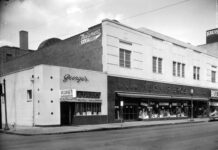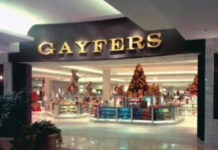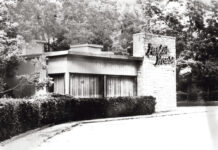
People arriving in Mobile for the very first time often have one question in common: Where’s the water? They’ve heard of Mobile’s status as a major port; they’ve seen maps showing the city’s location on rivers and the Bay. Yet the beautiful waterfront views they expect are nowhere in sight. It wasn’t always that way. Up until about the 1950s, the city’s commercial waterfront was freely accessible to the public, and a massively used recreational waterfront existed, as well. All of this is still within living memory; in sultry, pre-air conditioning days, the waterfront, with its cool breezes, was the place to be.
Mobile in the 1840s was a rollicking cotton port, and the Bay played an important role in the recreational life of Mobilians. At the foot of Conception Street was a tollbooth leading to a shell road that hugged the shoreline. This area was known as Frascati and is said to have catered to the recreational needs of the city’s upper-crust. Henry Nabring, who owned the famed Battle House hotel in Mobile, started the park in 1866. A carriage rider might stop there for a picnic under the trees. Or, after paying the toll keeper, the carriage could roll along the Bay, passing the home of Captain Monroe, and head towards the artesian springs and the large oaks where Bienville had his house and gardens.


In the 1890s, a country club was started on Bay Shell Road near Frascati. (It later moved to higher ground in Spring Hill along another shell road.) Also on the road was the Arlington Fair Grounds. Horse breeding and racing had long been important to the area. Used throughout the year, the fairground’s building also included permanent exhibits and hosted county fairs, as well as racing.
In 1893, a massive storm leveled Frascati, and it wasn’t rebuilt. Instead, a streetcar company constructed Monroe Park on an oak-fronted field facing the Bay as a destination to drum up weekend streetcar customers. The park itself was a pay-as-you-go enterprise that catered to the new class of urban workers looking to enjoy their leisure weekends and disposable incomes. A roller coaster, carousel, human oddities and other amusements were all located on the grounds. Bay Shell Road ran between it and the Bay and functioned as a strolling path. The water was used for bathing and boating, although the lack of sewage treatment rendered it somewhat ripe in the summer.

In the 1900s, a baseball stadium was built just off Washington Avenue, and in 1913, season attendance reached 100,000. The park was lit electrically at night and was open late on the weekends during the summer. To the left of the ballpark was the Crystal Pool, an amusement built on an artesian spring. The water was more yellow than crystal, but it offered a pleasant place to swim on a hot day. A little further down on the right was Arlington Point. Designated as the city pier, it was a peninsula created from fill going out a quarter mile into the Bay. A wooden extension took it out even further. Amusements included a movie theater, a rock garden and the Buccaneer Yacht Club clubhouse. It also was well lit and open late on Friday and Saturday nights. Further down the road still were shadier entertainment venues appealing to a more adult audience.
Later, in the 1930s and 1940s, several nightclubs such as The Night Spot lined Bayfront Road. Built out over the water, they featured dancing to big band and nickelodeon music.


Then, step by step, all of the access to the waterfront was lost to industry and the Brookley Field Air Force Base. When the Bankhead and Wallace / I-10 tunnels blocked access to the Alabama State Docks for deep-draft oceangoing ships and the docks began to expand south of the tunnels, the recreational waterfront seemed doomed for good.
Today, there is only a shadow of the former recreational waterfront. Looking out from the porch of an old outbuilding of the Frascati House, to the left you can see the oaks that once lined the waterfront at the tollhouse. The undulation of the land under these oaks might be left over from the country club’s golf course but may well be the remains of Civil War fortifications. The Crystal Pool spring is now piped into a culvert. Fort Whiting stands on the site of the fairgrounds, with the newer “Fairgrounds” on Cody Road not having any association with horses. Arlington Point is fenced in and used by the Coast Guard for buoy storage. If you look closely enough and squint, you can see how this must have been a neat place to sit and watch people.
Waterfront Timeline
1730s
Bienville builds his “chateau” in area now known as Garrows Bend.
1818
Captain Monroe builds his house in Mobile.
1860s
Site for Fort Sidney Johnson, southern defense for the city of Mobile.
1888
Map shows Frascati, Bay Shell Road.
1893
Hurricane levels Frascati.
1893
Monroe Park founded as a streetcar destination.
1897
First motion picture in Mobile viewed at Monroe Park.
1906
Hurricane washes away Bay Shell Road.
1916
Hurricane destroys Mobile Yacht Club and many buildings at Monroe Park.
1923
State Docks authorized.
1924
Babe Ruth hits home run in Monroe Park.
1926
Baseball stadium moved to Ann and Tennessee streets.
1936
Fort Whiting built on southeast corner of Arlington Fairgrounds.
1940
Southeast Army Air Depot construction started (became Brookley Field).
1942
Brookley reaches peak employment.
1946
Monroe Park no longer listed in the phone book.
1959
Industrial waterfront causeway completed, cutting off access.
1969
Brookley Field closes; title to Brookley wharf at old Arlington Park passes to City of Mobile.
1970s
McDuffie coal terminal built.
1980s
Title to Arlington pier passes to city, then to Mobile Airport Authority.
1980s
Mobile Airport Authority takes possession of city’s Brookley interest.
Late 1980s
Mobile banana docks razed to make way for a new convention center.
1995
Mayor Mike Dow proposes Monroe Park as the site for Hank Aaron Stadium.
2002
Committee to restore Monroe Park forms.
2004
The Mobile Cruise Terminal opens.
2010
Arlington Park is developed and opened by the Alabama State Port Authority.
2015
GulfQuest Maritime Museum opens.
Dr. Allen Perkins, chair and spokesperson of the Committee to Save Monroe Park, became an advocate for a recreational waterfront when he moved to Mobile thinking it was on the water, but found “if it was, it was a well-kept secret.” Perkins worked closely with the environmental group Mobile Bay Watch to ensure that a public waterfront facility would be built, along with the ASPA container facility. “People are realizing that just housing and jobs and food are not enough to make a city,” he says. “They’re realizing now that we have to work for a city with greater quality of life.”





